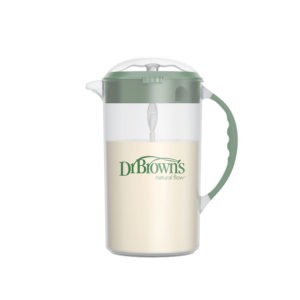New parents often feel overwhelmed trying to decide the “right” way to feed their baby, but there is no one-size-fits-all answer. Every family is unique, and the right feeding option is what works best for you and your baby. Formula feeding or breastfeeding doesn’t have to be an either/or situation.
What is Combo Feeding?
Combo feeding, also known as supplemental or mixed feeding, is feeding your baby a combination of breast milk and formula1. There are a variety of reasons for combo feeding such as low milk supply, returning to work, involving a partner in feedings, having multiples, wanting to extend breastfeeding, medical issues with mom or baby, or simply because you want to.
Benefits of Combo Feeding
Flexibility and convenience.
Breastfeeding and pumping can fill up your schedule, but with the addition of formula supplementation, you have more freedom in how and where you feed your baby. If you’re returning to work or school, for example, this gives you a bit more flexibility in feeding options.
Ensure baby gets enough milk.
Some moms may have difficulty producing enough milk. Supplementing with formula allows parents to rest easy knowing that their baby is getting enough to eat and taking in the nutrients they need to grow and thrive.
Allow other caregivers an opportunity to help.
Combo feeding also gives partners or other caregivers a chance to participate in feeding. This is a great way for dads, grandparents, or other family members to bond with the baby and share in the feeding responsibilities. Plus, mom can get some much-needed rest.
Help with breastfeeding challenges.
From low milk supply or pain while breastfeeding to any number of physical or medical conditions, sometimes breastfeeding doesn’t go as smoothly as desired. Formula feeding can help fill the gap until the issue is resolved or continue as a supplement to mom’s milk for as long as she and baby need it.
Tips for Successful Combo Feeding
Introduce formula feedings slowly.
When you are ready to begin offering formula, it’s best to start slowly so that your baby’s digestion is better supported. Choose a time when they’re a little hungry but still calm and happy, maybe an hour or two after a regular breastfeeding session. That way they get used to the taste of the formula and you’ve paved the way for an easier feeding next time. This also gives your body time to adjust to producing less breast milk and can help you avoid swollen breasts and discomfort.
Create a similar experience with both feedings.
Keeping similarities between breastfeeding and formula feeding will create a familiar routine for your baby and help to make the transition easier for you both. That might mean switching sides or giving skin-to-skin contact to mimic the experience of breastfeeding. And while it’s perfectly safe for the formula to be served room temperature or even cold2, some babies may prefer it to be warmed so that it’s more like mom’s milk.
Every baby is different and feeding styles vary across the board. If you’re considering adding formula into the mix and have questions, reach out to your doctor to help you find a routine that works for you and your baby.
Sources
- USDA WIC Breastfeeding Support. Combination Feeding and Maintaining Milk Supply, https://wicbreastfeeding.fns.usda.gov/combination-feeding-and-maintaining-milk-supply Accessed 7 July 2023.
- Mayo Clinic. 26 January 2023. Infant Formula: 7 Steps to Preparing it Safely. https://www.mayoclinic.org/healthy-lifestyle/infant-and-toddler-health/in-depth/infant-formula/art-20045791 Accessed 7 July 2023.

